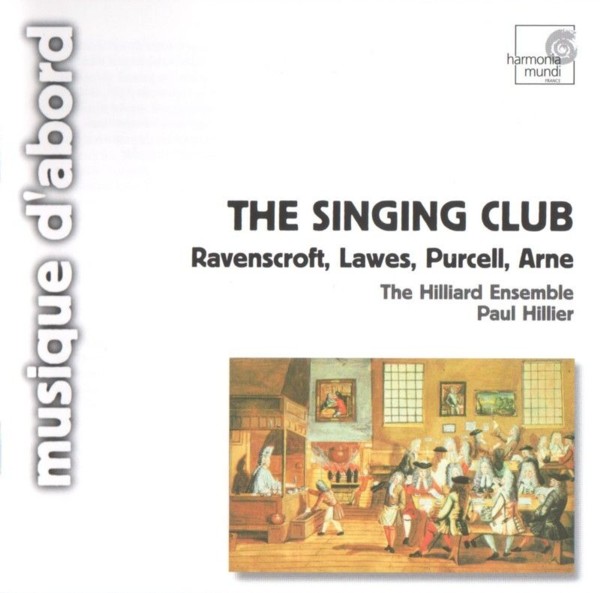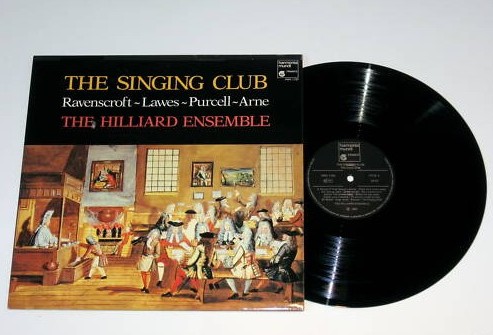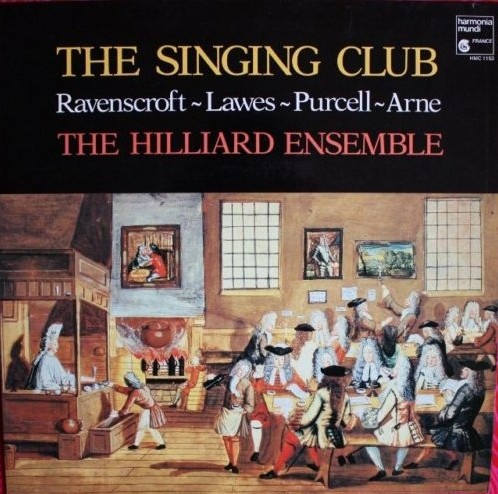The Singing Club. Ravenscroft, Lawes, Purcell, Arne
The Hilliard Ensemble

amazon.com
harmoniamundi.com
Harmonia Mundi HMA 1951153
2005
originally released in 1985, Harmonia Mundi HMC 1153
Enregistrement septembre 1984 au Henry Wood Hall, Londres
The Catch Club
Thomas RAVENSCROFT (c.1582-c.1635)
01 - A Round of three country dances in one [2:28]
02 - There were three ravens [6:45]
John HILTON (1599-1657)
03 - Call George again, boys [1:26]
William LAWES (1602-1645)
04 - Drink tonight of the moonshine bright [1:54]
05 - She weepeth sore in the night [1:54]
06 - Dainty fine aniseed water fine [1:29]
John WILSON (1595-1674)
07 - Where the bee sucks there suck I [1:18]
William LAWES
08 - Gather your rosebuds while you may [1:31]
Henry PURCELL (1659-1695)
09 - Tis woman makes us love [0:56]
10 - Sir Walter enjoying his damsel [1:49]
11 - an., 17th c. Inigo Jones [1:28]
Jonathan BATTISHILL (1738-1801)
12 - Epitaph [2:37]
Thomas ARNE (1710-1778)
13 - The Singing Club [2:32]
The Glee Club
Henry BISHOP (1786-1855)
14 - Foresters sound the cheerful horn [1:34]
Thomas ARNE
15 - To soften care [3:22]
John STAFFORD SMITH (1750-1836)
16 - The Anacreontick Song [4:31]
Thomas ARNE
17 - Elegy on the death of Mr. Shenstone [4:15]
18 - Sigh no more ladies [3:57]
Robert Lucas PEARSALL (1795-1856)
19 - There is a paradise on earth [3:49]
20 - O who will o'er the downs so free [1:56]
Joseph BARNBY (1838-1896)
21 - Sweet and low [2:56]

The Hilliard Ensemble
Paul Hillier
David James, contre-ténor
Roger Covey-Crump, John Potter, Paul Elliot, ténors
Paul Hillier, Michael George, Michael Pierce, basses

Singing clubs of one kind or another
played a small but significant role in the history of English convivial
music. The simplest venues for the singing of rounds and catches were
the 17th-century coffee-house and tavern, bustling with all manner of
activities. It is hard to imagine that the musical possibilities here
were of any great sophistication! Nevertheless, many composers, Purcell
the most prominent among them, created a series of fascinating
miniatures whose wit and melodic invention have rarely been equalled.
Earlier in the century, Thomas Ravenscroft had successfully tapped the
market for a simpler, more accessible kind of music. His anthologies
set rounds and harmonised ballads alongside the more typical polyphonic
pieces, and encouraged the amateur to lay down his viol and discover
the delights of singing. The lyrical trend continued in the catches and
ayres of the brothers Lawes and song composers such as John Wilson.
After the Civil War, the Commonwealth and the restoration of the
monarchy, London was ready for music of the greatest exuberance and, in
some cases, licentiousness. Wine, women, song, politics and social
satire became the subject-matter of Purcell and his companions; some of
the results are delightfully intriguing to the modern eye, though the
Victorians were scandalised.
The 18th-century catch and glee reflected the more formal, artificial
mood of the age, though this proved little constraint for Thomas Arne,
whose catches often encapsulate a miniature dramatic scene. At first
the bawdier elements of the repertoire remained in favour, though
gradually a more cautious taste developed and found its typical
expression in the glee, a hitherto neglected area of English music. The
glee was a specifically English creation — a partsong for three
or more solo voices, divided into separate sections in contrasting mood
and tempi. Moving away from the heterogeneous atmosphere of a public
room, glee clubs, catch clubs and madrigal societies now formed for the
express purpose of music-making... and dinner. Membership, rules and
traditions became a part of this and often the music that resulted lies
deservedly forgotten. But equally there are many examples of music of
great beauty and distinction which it is our pleasure to revive.
Many clubs had their own ‘theme-song’. One such was John
Stafford Smith's ‘Anacreontick Song’ which opened each
meeting of the Anacreontic Society, founded in 1766, which met in the
Crown and Anchor tavern on the Strand ‘for supper and the singing
of catches, glees and songs’. This tune has of course become
better known as America's ‘The stars and stripes’! In
Bristol a madrigal society was founded in 1837 which included amongst
its earliest members the composer Robert Lucas Pearsall. Although an
amateur, Pearsall wrote some outstandingly beautiful partsongs and
while they have enjoyed great popularity (‘O who will o'er the
downs’ is immediately recognised by the oldest members of English
audiences), it remains for modern music-lovers to rediscover his music
more fully. Henry Bishop, a prolific composer particularly of theatre
music, seems to have been regarded in his day as England's answer to
Beethoven. If this was not a good answer, it should not detract from
the popularity of his melodious glee ‘Foresters sound the
cheerful horn’, while the comfortable world of Victorian England
cradles us in its most endearing manner in the swaying harmonies of
Barnby's ‘Sweet and low’.
It remains to identify three names in the titles of this record.
‘Sir Walter’ is of course Sir Walter Raleigh —
courtier, adventurer and poet. The story told in the catch is recounted
more fully in John Aubry's 'Brief Lives’ (a 17th-century mixture
of biography and gossip):
‘He loved a wench well; and one time getting up one of the maids
of honour up against a tree in a wood ('twas his first lady) who seemed
at first boarding to be something fearful of her honour, and modest,
she cried, ‘Sweet Sir Walter, what do you ask me? Will you undo
me? Nay sweet Sir Walter! Sweet Sir Walter!’ At last as the
danger and pleasure at the same time grew higher, she cried in the
ecstasy ‘Swisser Swatter Swisser Swatter’. She proved with
child, and I doubt not but this hero took care of them both, as also
that the product was more than an ordinary mortal.’
Inigo Jones (1573-1652), whose name puns so conveniently, was the
famous architect who also did important work as designer of costumes
and scenery for court masques. William Shenstone (1714-1763) was a
minor 18th-century poet whose work Arne admired (for the purpose of
song texts). He cultivated his garden in the carefree English manner
and is regarded as one of the more original of early landscape
gardeners. But if we are to conclude to an extra-musical note, we
should return to Pearsall — whose interests and publications
embraced psalm-chanting, medieval instruments of torture, duelling,
'military engines before the invention of gunpowder', archaeology and
genealogy. Using the last skill, he traced his pedigree back to Edward
I and adopted a coat of arms (to which he had the right). He moved to
Switzerland for reasons of health and bought a castle — Wartensee
— near Lake Constance, where he died.
PAUL HILLIER




